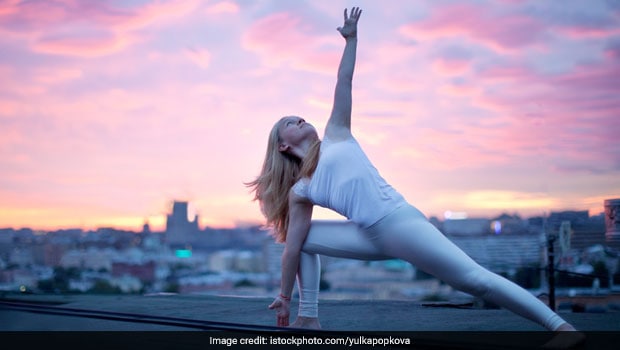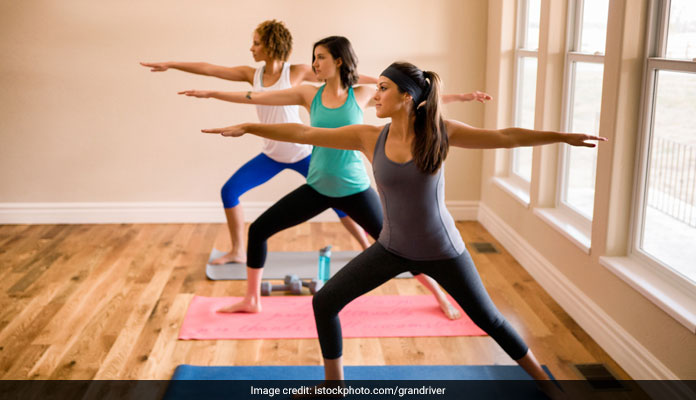Vinyasa Yoga: All About the 'Flow Yoga' and Why You Must Give it a Try
Vinyasa Yoga: All About the 'Flow Yoga' and Why You Must Give it a Try
 Yoga
is an age-old holistic practice, yet it has often meshed into newer
forms. We'd like to throw the spotlight on an interesting form of yoga
known as Vinyasa which involves the transition from one posture to
another without resting or taking a break. The practice of breathing
in and breathing out while getting into and out of a posture has great
importance while practicing Vinyasa yoga. The term Vinyasa is derived
from the words Vi and Nyasa which means, 'to place in a
special manner'. This denotes that the practice of Vinyasa yoga
involves the body to get into specific postures, to place each limb in a
particular position, synchronized with your breathing and to be mindful of the entire physical kriya.
The idea is to be aware of all different parts of the body, feel them
while getting into a posture, derive the most from an existing pose and
move on to the next one.Breathing Technique
Yoga
is an age-old holistic practice, yet it has often meshed into newer
forms. We'd like to throw the spotlight on an interesting form of yoga
known as Vinyasa which involves the transition from one posture to
another without resting or taking a break. The practice of breathing
in and breathing out while getting into and out of a posture has great
importance while practicing Vinyasa yoga. The term Vinyasa is derived
from the words Vi and Nyasa which means, 'to place in a
special manner'. This denotes that the practice of Vinyasa yoga
involves the body to get into specific postures, to place each limb in a
particular position, synchronized with your breathing and to be mindful of the entire physical kriya.
The idea is to be aware of all different parts of the body, feel them
while getting into a posture, derive the most from an existing pose and
move on to the next one.Breathing Technique
Your
breath is the connecting thread between two postures and this is why
Vinyasa yoga is also known as 'flow yoga'. Ujjayi breathing is practiced
while performing Vinyasa yoga - which means that you first fill your
stomach up followed by the rib cage, chest and then the throat. This
form of a breathing technique is practiced throughout while performing
Vinyasa yog.

Yoga is the slow and steady way to keep yourself fit and healthy.
Photo Credit: iStock
Photo Credit: iStock
The Vinyasa Effect
Since Vinyasa yoga is a quite a dynamic form of yogic practice (and you can always play around with the intensity and speed
of getting in and out of the postures), it is something that will
generate heat in your body. Vinyasa yoga is excellent for body
strengthening, flexibility, shedding weight, boosting metabolism and
gaining muscles. It combines various classes of postures together - from
standing poses to forward and backward bends, bodily twists et cetera.
Therefore, it is like a complete body workout. You become more aware of
your body and more mindful of its capabilities. Vinyasa yoga challenges
your physical limitations and prepares the body for more strenuous
experiences.
The Flow
An
ideal sequence of postures in a Vinyasa practice can be a product of
various poses tailor-made by your instructor. The thumb rule is that you
begin and end on the same posture, always. For example, you can begin
with the Four-limbed staff pose (Chaturanga Dandasana), move on to the Upward Facing Dog Pose (Urdhva Mukha Svanasana), then on to the Downward Facing Dog (Adho Mukha Svanasana) and finally back to the staff pose. Many instructors may take you through the Child's Pose to the Corpse Pose to actually exhibit various stages of life through yogic expression.

The cobra pose.
Photo Credit: iStock
Photo Credit: iStock
"Vinyasa
means arranging something in a special way. It is a flow form of yoga
that coordinates the movements with breath. Each step is a breathe in
followed by a breathe out. Here the heart opener postures follow the
forward bends," shared yog expert Manisha Kohli who also co-owns a The
Yoga Chakra studio in Delhi.
Yoga is something that can easily be included in your daily routine. All it takes is a yoga mat and some dedication and persistence. Any form of physical activity is great for you to break the vicious cycle of a sedentary lifestyle. Get in touch with a certified yoga expert to learn more about Vinyasa yoga and how can you reap maximum benefits by practicing it.
Yoga is something that can easily be included in your daily routine. All it takes is a yoga mat and some dedication and persistence. Any form of physical activity is great for you to break the vicious cycle of a sedentary lifestyle. Get in touch with a certified yoga expert to learn more about Vinyasa yoga and how can you reap maximum benefits by practicing it.













No comments
Post a Comment